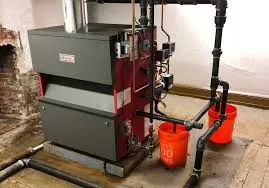steam boiler for sugar company
The Role of Steam Boilers in Sugar Manufacturing
Steam boilers play a critical role in the sugar industry, providing the necessary heat for various processes essential to sugar production. The sugar manufacturing process, from raw cane milling to refinement and crystallization, relies heavily on steam generated by these robust systems. This article explores the importance of steam boilers in sugar companies, their operational principles, types, and the benefits they offer.
Understanding the Sugar Manufacturing Process
The production of sugar begins with the harvesting of sugarcane or sugar beets. Once the raw material is collected, it undergoes several processing stages, including crushing, juice extraction, clarification, evaporation, and crystallization. Each of these stages requires significant thermal energy, which is where steam boilers become indispensable.
How Steam Boilers Work
Steam boilers convert water into steam through the combustion of fuels such as natural gas, biomass, or coal. The generated steam is then directed to various equipment in the sugar plant to provide heat for critical operations. For example, in the juice extraction phase, steam is used to heat the cane or beet slices, breaking down the cellular structure and releasing the sugar-laden juice. In the evaporation stage, steam is applied to concentrate the juice by removing excess water, which is vital for producing high-quality sugar crystals.
There are generally two types of steam boilers used in sugar companies fire-tube boilers and water-tube boilers. Fire-tube boilers, where hot gases pass through tubes filled with water, are popular due to their simplicity and ease of operation. Water-tube boilers, on the other hand, circulate water through tubes exposed to hot combustion gases, making them more suitable for high-pressure applications. Each type has its advantages and can be selected based on the specific needs and scale of the sugar facility.
Benefits of Using Steam Boilers in Sugar Production
steam boiler for sugar company

1. Energy Efficiency Modern steam boilers are designed to be highly efficient, allowing sugar companies to maximize output while minimizing fuel consumption. The use of waste heat recovery systems can further enhance efficiency, ensuring that energy costs are kept under control.
2. Process Control Steam boilers provide precise temperature control, which is crucial for maintaining optimal conditions during various stages of sugar processing. This consistency helps ensure the quality of the final product and minimizes the risk of production errors.
3. Sustainability With the increasing emphasis on sustainable production methods, many sugar companies are opting for biomass or other renewable fuel sources for their steam boilers. This shift not only reduces the carbon footprint of sugar production but also supports the local economy by utilizing agricultural byproducts.
4. Scalability Sugar production is often seasonal and can vary significantly in scale. Steam boilers are available in various sizes and configurations, allowing sugar companies to scale their operations effectively without compromising on steam availability.
5. Economical Operation The use of steam boilers in sugar manufacturing can significantly reduce operating costs. By maximizing energy efficiency and reducing waste, companies can improve their overall profitability.
Conclusion
In summary, steam boilers are integral to the sugar manufacturing process, providing essential thermal energy for various stages of production. Their efficiency, versatility, and ability to enhance product quality make them a vital component of modern sugar companies. As the industry continues to evolve towards more sustainable practices, the role of steam boilers will remain crucial in optimizing production and ensuring economic viability. With ongoing advancements in boiler technology, the future of steam generation in the sugar industry looks promising, paving the way for more efficient and environmentally friendly operations.
-
High-Efficiency OEM Steam Boilers w/GPT-4-TurboNewsAug.02,2025
-
Advanced Electric Steam Boiler Manufacturers | GPT-4 Turbo AINewsAug.01,2025
-
Custom Steam Boilers Manufacturer | AI-Enhanced EfficiencyNewsJul.31,2025
-
Top Electric Steam Boiler Makers | AI-OptimizedNewsJul.31,2025
-
Top Electric Steam Boiler Manufacturers - High Efficiency SolutionsNewsJul.30,2025
-
Top Electric Steam Boiler Manufacturers – Efficient Industrial SolutionsNewsJul.29,2025

